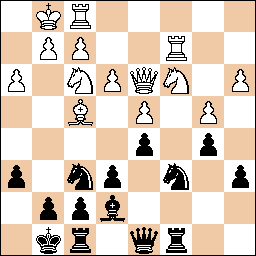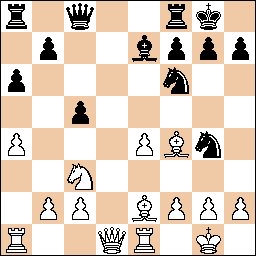Friday, July 28, 2006
Winning Combination

I got in some more solid blitz games of (5/12) and in a rare occurrence I sacrificed my Queen to win! Finding Queen to a2 to reach the above positioned was extremely difficult. I think following this position all the way through is a treat. The continuation is 36...Qxb1!+ 37.Qxb1 Ra1 38.Qxa1 bxa1=Q+ 39.Bxa1 Rb1+, forking the King and Bishop.
1.e4 e5 2.Nf3 Nf6 3.Nc3 Bb4 4.d3 Bxc3+ 5.bxc3 d6 6.Bg5 O-O 7.Be2 c5 8.O-O Nc6 9.Nd2
b5 10.Re1 a5 11.Nf1 b4 12.c4 Nd4 13.Ne3 h6 14.Bh4 g5 15.Bg3 h5 16.Bxh5 Kg7 17.Nd5
Nxh5 18.Qxh5 Nxc2 19.Ne3 Rh8 20.Qd1 Nxa1 21.Qxa1 Be6 22.f4 f6 23.f5 Bf7 24.Rf1 a4
25.Nd5 Bxd5 26.cxd5 b3 27.axb3 axb3 28.Qc3 Rb8 29.Rb1 Qb6 30.Bf2 Qb4 31.Qc1 b2 32.Qc2
Qb3 33.Qe2 Qa2 34.Qc2 Rb7 35.Be1 Ra8 36.Bc3 Qxb1+ 37.Qxb1 Ra1 38.Qxa1 bxa1=Q+ 39.Bxa1
Rb1+ {White resigns} 0-1
-=-=-=-=-
I just went through the Seirawan v. Ivanchuk game in the McDonald book The Art of Logical Thinking and I think it is one of the best in the book. It is a KID gone really bad for Black, over in 22 moves!
-=-=-=-=-
I just lost a 45/45 game to a 1700 + 10 year old. I played well, and it was extremely even through most of it, but I lost to a miscalculation in the late middlegame (24). I really didn't think about prophylactic moves, just tactics, and it cost me. Hopefully lessened learned!
Anyone know the KID?
It seems like a few years ago the Bayonet variation (1. d4 Nf6 2.c4 g6 3.Nc3 Bg7 4.e4 d6 5.Nf3 0-0 6.Be2 e5 7.0-0 Nc6 8.d5 Ne7 9.b4 ) became viewed best for White at the professional level, and soon after scores of amateurs started using it. Of all the books I own and have checked out of my local library, not one had that variation except Batsford Chess Openings, and that book was over my head.
I have to questions that I am puzzling through. First, Black's option of 7...Nd7 would appear to change the situation, avoiding that line. With 7...Nd7 Black is no longer losing a tempo to the d5 push, yet the move does not seem as popular according to my database. I am guessing that the advantage of 7...Nc6 8.d5 Ne7 is that it supports the f5 push?
My second question is about other lines where White starts improvising out of book but then throws in the b4 early, should Black be considering ...a5 early or other ideas as prevention?
edit: I have been directed to read Bronstein's Zurich 1953. I imagine 350 pages gone through 7 circles would serve as a nice introduction...
Wednesday, July 26, 2006
Good Game
My opponent played the opening ok (he lost a tempo) and then he got into an early attack before castling. I defended really well, countered with 12...d5, then White's position fell apart and he resigned, down 3 pawns in a passive position. I actually was hazy on his response of 13. d4, but as much as I could calculate 12...d5 was the best, especially in view of his wing attack potential.
-=-=-=-=-
Back to normal mistakes... I have been not playing blitz very well, probably it doesn't matter :). Here my opponent had a good move:
Black to Move
..
..
..
.
Bxb4! and White cannot recapture without getting forked with discovery with axb4 Nxb4.
Tuesday, July 25, 2006
Tasc Chess Tutor Errata
Step 2, exercise 8b, #2: 1. f4 is better but marked incorrect. 1. Qa3 is met by this:
1...Rfxf2 2.Nf7+ Kg8 3.Qf8+ Kxf8 4.Nxg5 Rxf1+ 5.Rxf1+ Nf5 6.a5 Ra2 7.Ne6+ Ke7 8.Re1 Rxa5 9.Kf2
Step 2, exercise 12h, #10 NOTE: 1... Ne3 is best but it is certainly not mate:
1... Ne3 2. Bf4! Rxf4 3. Rg1+ Kf8 4. Qxd5 Nxd5
------------------------------------------------------------------
Step 3, exercise 10d, #5: 1. Rg5+, 1. Rg4+, and 1. Rg3+ are equal but marked incorrect
Step 3, exercise 17f, #9: 2. Qf8# is equal but marked incorrect
------------------------------------------------------------------
Step 4, exercise 3d, #2: 1. Qc4+ and 1. h3 are better but marked incorrect
1. +- (9.70): 1.h3 Qg6 2.Nh4 Qe8 3.Nf5 Nc5 4.Qd6 Rxd6 5.Nxd6+ Kd7 6.Nxe8 Kxe8
2. +- (9.20): 1.Qf7 Bc5 2.Bd5 Rf8 3.Bxb7+ Kd8 4.Qc4 Ke7 5.Rfd1 Rd8
3. +- (8.55): 1.Qc4+ Kb8 2.Qb4 Rc8 3.a5
4. +- (7.96): 1.Rxb6 Nxb6 2.Qc5+ Kb8 3.Qxb6 Qd7 4.Bd5 Qc7 5.Rb1 Qxb6 6.Rxb6 Rd7 7.a5
Step 4, exercise 7b, #4 NOTE: 1. Re8 Ra8!! draws
1. = (0.00): 2...h2 3.Rh8+ Nh7 4.Rg8 Ng5 5.Rh8+
2. = (0.00): 2...Kh7 3.Ra7+ Kh6
Step 4, exercise 14a, #5: 1. Rab2 is worse but marked as correct (it draws)
Step 4, exercise 16e, #5: 1. Nxc4 is equal but marked incorrect,
also 1. Ne5 is almost equal but marked incorrect
1. (-0.79): 1...Rxf3 2.Qxf3 Ne5 3.Bxe6+ Bxe6 4.Qg3 Rf8 5.Red1 h6 6.Bf4
2. (-0.79): 1...Nxc4 2.Qxc4 Rxf3 3.hxg4 Rf7 4.Qd3 Bd7 5.Be3 Be5 6.g5 Bc6 7.Red1
3. (-0.65): 1...Ne5 2.Nxe5 Bxe5 3.Rf1 Nxc4 4.Qxc4 b5 5.Qd3 c4 6.Qe3 b4 7.f4
------------------------------------------------------------------
Step 5, exercise 2c, #8: 2. Nce6+ is equal but is marked incorrect
Step 5, exercise 3a, #6: 1. a5 draws but is marked incorrect
Step 5, exercise 5b, #5: 1...Ka3 draws but is marked incorrect
Step 5, exercise 6a, #5: 2. c5 is better but is marked incorrect
Step 5, exercise 7a, #10: 1... d5 is slightly better but marked it as incorrect.
Step 5, exercise 7b, #7: deep computer analysis marks Nf3+ as best:
1. -+ (-3.33): 1...Nf3+ 2.Bxf3 Be5+ 3.Kg2 Qxe3 4.Qxg8+ Kxg8 5.Bxa8 Bd4 6.Kh2+ Kf8 7.Rgf1 Qe5+ 8.Rf4 Be3 9.Kg3 Bxf4+ 10.Rxf4
2. -+ (-2.93): 1...Ng4+ 2.hxg4 Be5+ 3.Kh3 Rxg5 4.Bxg5 Qxc2 5.Rgf1 f6 6.Bh6 Qxa2 7.Bf3 Qb3 8.Bf8
Step 5, exercise 7c, #10: 2... Ncxd4 is better but is marked incorrect (gets an additional pawn)
Step 5, exercise 9a, #9: 3. Rb8 is equal but marked incorrect
Step 5, exercise 9b, #5: 1. Rc7+ is equal but marked incorrect
Step 5, exercise 11c, #6: 4. Qh7# is equal but marked incorrect
Step 5, exercise 17e, #2: 1. Nh5 is equal but marked incorrect,
also 1.f6 exf6 Nh5 is equal but marked incorrect
Step 5, exercise 17e, #9: 1. Ne3 is better but marked "not bad"
Thursday, July 20, 2006
Call for TCT Glitches
I wanted to report in that I have yet to get my standard under control, but I am occasionally putting together really tough 5/12 blitz games. This isn't like the sloppy wins over 1400 + blitz folks, and I hope I can continue to solidify my play.
Here is one where I accidentally opened e4. (d4 or Nf3 is what I usually play).
1. e4 e5 2. Nf3 d6 3. Nc3 c6 4. d4 exd4 5. Nxd4 Nf6 6. Be2 Be7 7. O-O O-O
8. Re1 Nbd7 9. a4 c5 10. Ndb5 a6 11. Nxd6 Ne5 12. Nxc8 Qxc8 13. Bf4 Neg4
14. h3 Rd8 15. Qc1 Nh6 16. Bxh6 gxh6 17. Qxh6 Rd6 18. e5
{Black resigns} 1-0
White to Move
...
..
.
Here I missed Nd5! threatening two forks with Nb6 and Nxe7. Nd5 Nxd5 Bxg4 threatens Black's Queen with Black's d5 Knight under the threat of Qxd5 or even exd5, getting a passed pawn. Not taking with Nd5 Re8 leads to Nb6, ensnaring at least a Rook.
Thursday, July 13, 2006
And Chess Marches On...
I must say I enjoy not be so intense about solving problems. I have already gotten into a more balanced mindset, looking at annotated games, a bit of endgame stuff, and openings every week. Speaking of openings, after getting the suggestion from Dr. Munky, I looked into the Cunningham defense in the King's Gambit Accepted. I think it is a sharp and intriguing line, but slightly over my level. I think I will play around with it in blitz and rely on the prosaic 2..Bc5 for standard. I can imagine going into the Cunningham defense when faced with a lower rated opponent for some reason.
I would be curious if anyone else used the Cunningham defense. I imagine Tempo and Takchess would play that style very well.
Monday, July 10, 2006
Done! Circle 7 Step 5 Complete
What now? Probably a brief rest, and then I hope to keep my chess studies going, albeit in a more balanced format with opening and endgame material. I actually feel like the new information I have taken in from TCT is more knowledge rather than chess ability. Perhaps over time this will shift. I believe TCT was addressed the weakest part of my game, and because of improvements there I hope to someday I hit ICC 1600. Oh, and pull off some combinations :-).
As far as this blog: I don't plan on going away completely, but I do seem to be heading in other directions and already seem to be posting much less. Reading and writing blogs does take time. Anyway, I wanted to say thanks for the encouragement and for reading, and in the words of Pete Tamburro,"Wishing you good chess wherever you may be".
TCT Results | Circle 1 | Circle 2 | Circle 3 | Circle 4 | Circle 5 | Circle 6 | Circle 7 |
| Step 1 | 97% | 99% | 99% | 100%r | |||
| Step 2 | 93% | 96% | 95% | 97% | 96% | 99% | 100% |
| Step 3 | 93% | 97% | 97% | 96% | 96% | 98% | 99% |
| Step 4 | 80% | 86% | 90% | 92% | 89% | 94% | 95% |
| Step 5 | 74% | 77% | 83% | 87% | 88% | 91% | 93% |
Thursday, July 06, 2006
The Vicissitudes of Amateur Chess
I am half finished with the last mighty circle...
TCT Results | Circle 1 | Circle 2 | Circle 3 | Circle 4 | Circle 5 | Circle 6 | Circle 7 |
| Step 1 | 97% | 99% | 99% | 100%r | |||
| Step 2 | 93% | 96% | 95% | 97% | 96% | 99% | 100% |
| Step 3 | 93% | 97% | 97% | 96% | 96% | 98% | 99% |
| Step 4 | 80% | 86% | 90% | 92% | 89% | 94% | 95% |
| Step 5 | 74% | 77% | 83% | 87% | 88% | 91% | 94%* |


